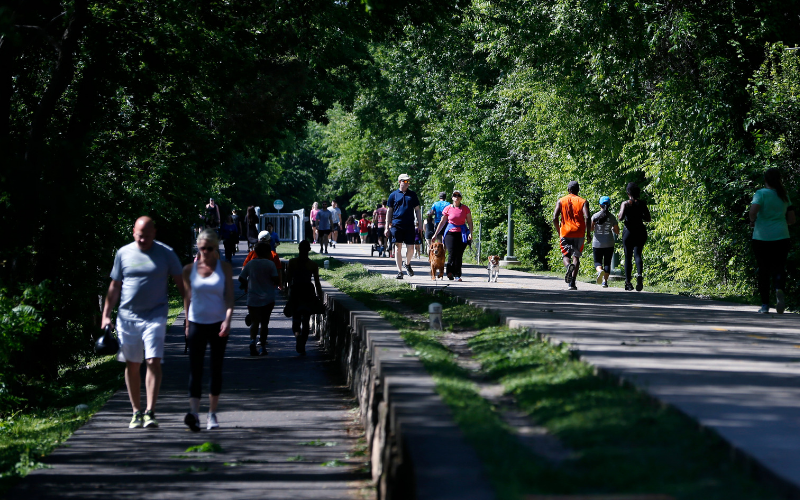While the Katy Trail might not fit your typical image of a park, it is one of the most important public spaces in Dallas. Stretching 3.5 miles long and connecting Victory Park to Highland Park, the trail has become a defining feature of the city and a popular amenity enjoyed by over one million visitors each year.
The history of the Katy Trail
Looking at the green-lined Katy Trail today, you might be surprised to learn it was once home to the Missouri–Kansas–Texas railroad line. This line, established in 1865 during the Reconstruction era, was the first railroad to enter Texas from the north. It was known as the K-T, or Katy, for short.
Over 100 years later, in 1993, Union Pacific Railroad donated the then-abandoned lines to the city. Though there was initial talk of turning the tracks into a DART line, a group of individuals and local businesses advocated for an urban park instead. The Friends of Katy Trail was founded in 1997 to rally support for the project, and in 2000, construction on the trail officially began.
SWA Group, a worldwide landscape architecture, urban design and planning firm, created the trail’s Master Plan; the firm is currently hard at work on Downtown’s Pacific Plaza.
A fitness destination
Once completed, it didn’t take long for the Katy Trail to become a destination for fitness lovers. As the popular saying goes, “Trains don’t run here anymore — Dallas does.”
The main trail consists of a 12-foot-wide concrete path where you can spot runners, walkers, cyclists and inline skaters passing in both directions. Sitting just parallel to the main path is a smaller trail made of soft rubber material that is reserved for pedestrians only. The Katy Trail is also equipped with overhead lighting, lookout points and plazas, numerous street access points, mile markers and water fountains (for both humans and pups).
Katy Trail is a designated City of Dallas park and maintains regular park hours of 5 a.m. to midnight.
The trail today
The Katy Trail today is a welcome reprieve from the hustle and bustle of some the densest areas of the city, as it snakes through much of Uptown. Construction of the trail has also increased value in the area, and numerous large apartment complexes have since been built backing right up to the trail and advertising their direct access to this Dallas hotspot.
The trail also hosts numerous races and events each year. The popular Katy 5K runs every summer and recently celebrated its 20th anniversary. Carry the Load, and two-day event to honor American servicemembers, is another popular city event that takes place partly on the Katy Trail.
The trail has even created a new drinking and dining destination: the Katy Trail Ice House. This beer garden and restaurant can be found near the trail’s south end and is a popular stopping-off point for runners, walkers and cyclists looking to celebrate a hard workout with a cool refreshment.
Since the trail’s completion, there has been talk of connecting Katy with other existing city trail systems. Branded as “The Loop,” this 50-mile dedicated hike and bike trail would connect Dallas’ major neighborhoods and make the city friendlier to pedestrians. The full trail has yet to be realized.
What’s your favorite way to take advantage of Dallas’ Katy Trail? Share your thoughts with us on Facebook, Instagram and Twitter.
The Iconic Park series highlights the parks, trails and public spaces unique to Dallas. Although Downtown Dallas Parks Conservancy’s mission is to build the four priority parks in Downtown, we recognize the value in promoting the success of all parks and green space across the city.


